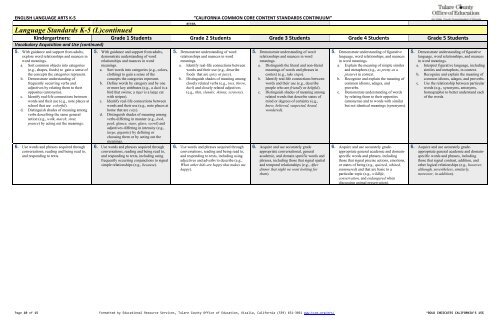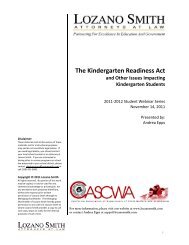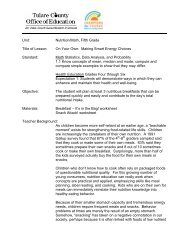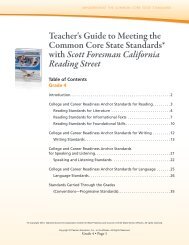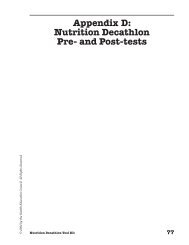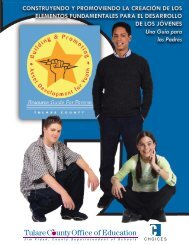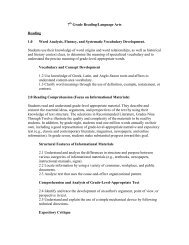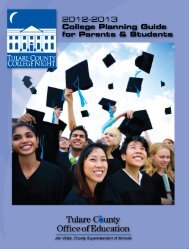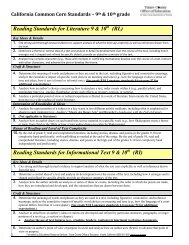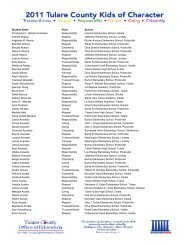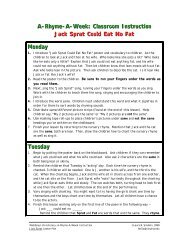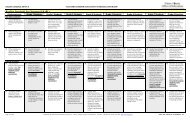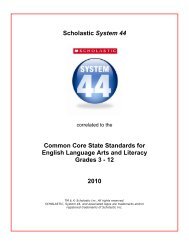CCCS K-5 ELA Continuum - Tulare County Office of Education
CCCS K-5 ELA Continuum - Tulare County Office of Education
CCCS K-5 ELA Continuum - Tulare County Office of Education
- No tags were found...
You also want an ePaper? Increase the reach of your titles
YUMPU automatically turns print PDFs into web optimized ePapers that Google loves.
ENGLISH LANGUAGE ARTS K‐5 “CALIFORNIA COMMON CORE CONTENT STANDARDS CONTINUUM”areas.Language Standards K-5 (L)continuedKindergartners: Grade 1 Students Grade 2 Students Grade 3 Students Grade 4 Students Grade 5 StudentsVocabulary Acquisition and Use (continued)5. With guidance and support from adults,explore word relationships and nuances inword meanings.a. Sort common objects into categories(e.g., shapes, foods) to gain a sense <strong>of</strong>the concepts the categories represent.b. Demonstrate understanding <strong>of</strong>frequently occurring verbs andadjectives by relating them to theiropposites (antonyms).c. Identify real-life connections betweenwords and their use (e.g., note places atschool that are colorful).d. Distinguish shades <strong>of</strong> meaning amongverbs describing the same generalaction (e.g., walk, march, strut,prance) by acting out the meanings.6. Use words and phrases acquired throughconversations, reading and being read to,and responding to texts.5. With guidance and support from adults,demonstrate understanding <strong>of</strong> wordrelationships and nuances in wordmeanings.a. Sort words into categories (e.g., colors,clothing) to gain a sense <strong>of</strong> theconcepts the categories represent.b. Define words by category and by oneor more key attributes (e.g., a duck is abird that swims; a tiger is a large catwith stripes).c. Identify real-life connections betweenwords and their use (e.g., note places athome that are cozy).d. Distinguish shades <strong>of</strong> meaning amongverbs differing in manner (e.g., look,peek, glance, stare, glare, scowl) andadjectives differing in intensity (e.g.,large, gigantic) by defining orchoosing them or by acting out themeanings.6. Use words and phrases acquired throughconversations, reading and being read to,and responding to texts, including usingfrequently occurring conjunctions to signalsimple relationships (e.g., because).5. Demonstrate understanding <strong>of</strong> wordrelationships and nuances in wordmeanings.a. Identify real-life connections betweenwords and their use (e.g., describefoods that are spicy or juicy).b. Distinguish shades <strong>of</strong> meaning amongclosely related verbs (e.g., toss, throw,hurl) and closely related adjectives(e.g., thin, slender, skinny, scrawny).6. Use words and phrases acquired throughconversations, reading and being read to,and responding to texts, including usingadjectives and adverbs to describe (e.g.,When other kids are happy that makes mehappy).5. Demonstrate understanding <strong>of</strong> wordrelationships and nuances in wordmeanings.a. Distinguish the literal and non-literalmeanings <strong>of</strong> words and phrases incontext (e.g., take steps).b. Identify real-life connections betweenwords and their use (e.g., describepeople who are friendly or helpful).c. Distinguish shades <strong>of</strong> meaning amongrelated words that describe states <strong>of</strong>mind or degrees <strong>of</strong> certainty (e.g.,knew, believed, suspected, heard,wondered).6. Acquire and use accurately gradeappropriate conversational, generalacademic, and domain specific words andphrases, including those that signal spatialand temporal relationships (e.g., Afterdinner that night we went looking forthem).5. Demonstrate understanding <strong>of</strong> figurativelanguage, word relationships, and nuancesin word meanings.a. Explain the meaning <strong>of</strong> simple similesand metaphors (e.g., as pretty as apicture) in context.b. Recognize and explain the meaning <strong>of</strong>common idioms, adages, andproverbs.c. Demonstrate understanding <strong>of</strong> wordsby relating them to their opposites(antonyms) and to words with similarbut not identical meanings (synonyms).6. Acquire and use accurately gradeappropriategeneral academic and domainspecificwords and phrases, includingthose that signal precise actions, emotions,or states <strong>of</strong> being (e.g., quizzed, whined,stammered) and that are basic to aparticular topic (e.g., wildlife,conservation, and endangered whendiscussing animal preservation).5. Demonstrate understanding <strong>of</strong> figurativelanguage, word relationships, and nuancesin word meanings.a. Interpret figurative language, includingsimiles and metaphors, in context.b. Recognize and explain the meaning <strong>of</strong>common idioms, adages, and proverbs.c. Use the relationship between particularwords (e.g., synonyms, antonyms,homographs) to better understand each<strong>of</strong> the words.6. Acquire and use accurately gradeappropriategeneral academic and domainspecificwords and phrases, includingthose that signal contrast, addition, andother logical relationships (e.g., however,although, nevertheless, similarly,moreover, in addition).Page 10 <strong>of</strong> 15 Formatted by <strong>Education</strong>al Resource Services, <strong>Tulare</strong> <strong>County</strong> <strong>Office</strong> <strong>of</strong> <strong>Education</strong>, Visalia, California (559) 651‐3031 www.tcoe.org/ers/ *BOLD INDICATES CALIFORNIA’S 15%


